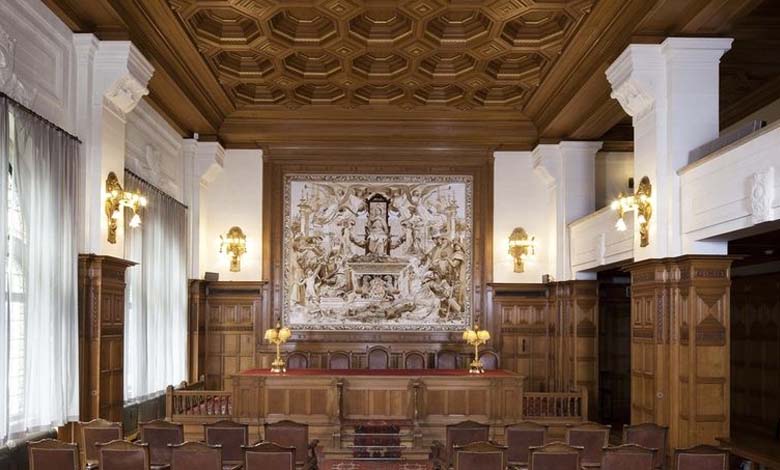Gaza Attends “Justice”… Learn About the Story of “Peace Palace”

Sculptures and paintings transport you back to a time where narratives of beauty intersect, scattering history’s essence before “peace” captures your moment in its original era.
In the Peace Palace in The Hague, Netherlands, you won’t feel the weight of a building considered the “headquarters of international law” because every detail narrates a story far from the rigidity of rules and legal standards. Before attempting to delve into the depths of the vast building, you’d want to uncover the secrets of every corner, relishing in every intricate line of its interior and exterior design, tracing its decorations, sculptures, and ceiling paintings. Beauty defies time to preserve all its components in their original state, making the entire building resemble a fortress uprooted from the depths of the 19th century and placed in the 21st century with all the architectural grandeur and historical pride it carries.
-
Latest Developments in the Gaza War: Israel Ignores Warnings and Prepares for a Larger Incursion in Rafah
-
Gaza Aid Shifts Allies’ Compass… France Criticizes Israel and Warns
The palace not only retains elements of its decoration but also continues to embrace everything offered to it in the form of gifts, whether sculptures or different materials, hiding them in its corners to accumulate a wealth of styles and details.
To this palace, the world’s attention turns today, Friday, as the International Court of Justice is expected to hold a public session at three o’clock in the afternoon to issue its decision regarding South Africa’s request to order Israel to cease fire in Gaza.
Pretoria wants the court to order Israel to “immediately” halt all military operations in Gaza, including Rafah City, where ground operations have been initiated despite international opposition.
The court said in a statement issued on Thursday that “a public session will be held at three o’clock in the afternoon at the Peace Palace in The Hague.”
The court adjudicates disputes between states, and its judgments are legally binding, but it lacks mechanisms for enforcement. However, a decision in favor of Pretoria would be a new blow to Israel.
The decision – if issued – would come after the prosecutor of the International Criminal Court, Karim Khan, requested arrest warrants against Israeli Prime Minister Benjamin Netanyahu and his defense minister, Yoav Gallant, and three Hamas leaders, on charges of committing alleged crimes in Gaza and Israel.
Since Israel took control of the Palestinian side of the Rafah border crossing with Egypt weeks ago, the entry of humanitarian aid, especially essential fuel for hospitals and humanitarian logistics services, has stopped.
Before its incursion into Rafah, the Israeli army ordered extensive evacuations in the eastern province, where it says it wants to destroy the last of Hamas‘s brigades and its tunnel network, and rescue hostages.
According to the United Nations, these operations have displaced 800,000 people, while one million Palestinians in Gaza face “catastrophic levels of hunger.”
From Another Era
After the establishment of the court under the Hague Convention of 1899, which defines the laws and customs of war, it was necessary to provide a headquarters for that court. Hence the construction of the “Palace of Peace” in 1907 before it was officially opened in 1913.
In the first year, 26 countries gathered in the “First Hague Peace Conference,” where they agreed to establish the Permanent Court of Arbitration and the Peace Palace.
Years later, specifically in 1907, the “Second Hague Peace Conference” was held with the participation of 44 countries, during which the cornerstone of the Peace Palace was laid.
Even before its construction, the purpose of the building was not only to serve as the headquarters of the Permanent Court of Arbitration but also to house the largest library in the field of international law and peace.
Indeed, the construction was completed, and the key to the palace was handed over on August 28, 1913, in the presence of the Dutch royal family, the financier Andrew Carnegie, an international group of lawyers, politicians, and peace advocates.
Over time, the components of the palace branched out to reach what it is now. In addition to the Permanent Court of Arbitration, it also houses the International Court of Justice, a UN agency, the Hague Academy of International Law, and a library.
-
Hamas Flexibility Revives Hopes for Ceasefire in Gaza
-
How the Muslim Brotherhood Exploited the Events in Gaza… What’s Iran’s Role?
The owner and manager of the palace are the Carnegie Foundation. Despite the passage of time on the building, it still retains all its splendor and beauty until today, making it unimaginable for those visiting for the first time that this architectural masterpiece originated from the late 19th century.
Its exterior design still pulses with narratives of past and present history, while its interior decorations remain adorned with sculptures, and its ceilings cling to original paintings that bring life. In all corners of the palace, the model of peace is reflected in every detail, while the images and sculptures translate the motto “Peace for Law.”
-
Displacement, Illness, and Hunger: Some Features of the Humanitarian Catastrophe Sweeping Gaza
-
How does Gaza prepare for Ramadan?
As for the gifts presented to the palace in the form of sculptures or materials, they paint a hanging picture in the folds of history, showcasing a volume of timeless and resilient details amidst its flow.












